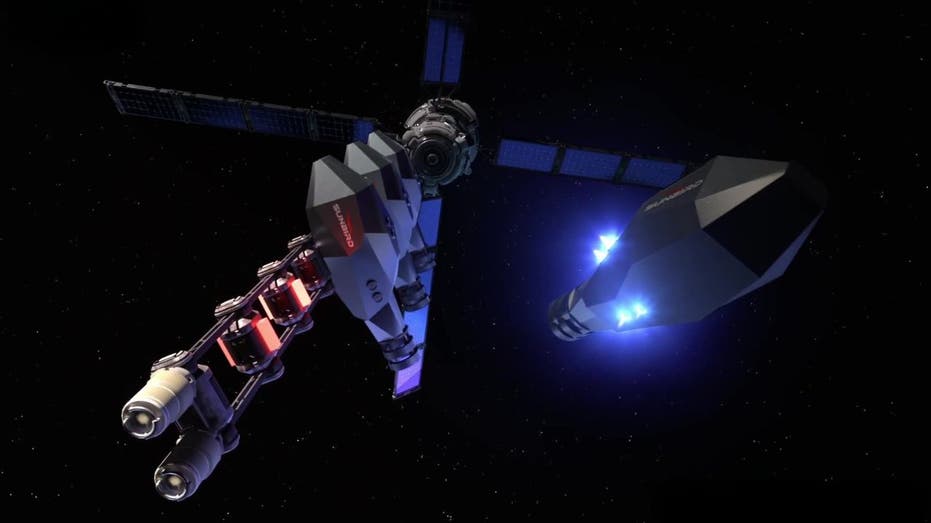329,000 mph nuclear rocket leading next era of space travel
Published
April 24, 2025 6:00am EDT close 'CyberGuy': 329,000 mph nuclear rocket leading next era of space travel Tech expert Kurt Knutsson says 329,000 mph fusion rocket promises to be fast, disruptive and enable deep-space missions. Get ready because the future of traveling to other planets just got a massive upgrade. Pulsar Fusion, a U.K.-based aerospace company, is developing a compact fusion engine called the Dual Direct Fusion Drive that could drastically change space exploration as we know it. This engine powers their Sunbird spacecraft, which promises to make space missions faster, cheaper and more efficient.Join the FREE "CyberGuy Report": Get my expert tech tips, critical security alerts and exclusive deals, plus instant access to my Compact fusion engine called the Dual Direct Fusion Drive (Pulsar Fusion) (Kurt "CyberGuy" Knutsson)What makes Sunbird special?Can you imagine a spacecraft that can reach speeds of almost 329,000 mph? That's what Sunbird is aiming for. This incredible speed is due to its nuclear fusion propulsion system. The Sunbird boasts a high specific impulse and an integrated 2 MW power system, making it a reusable transfer vehicle perfect for those deep-space missions that are currently out of reach. Compact fusion engine called the Dual Direct Fusion Drive (Pulsar Fusion) (Kurt "CyberGuy" Knutsson)How does it work?The Dual Direct Fusion Drive is designed to produce thrust and continuous electrical power; think of it as the ultimate energy-efficient engine. It can deliver between 10,000 and 15,000 seconds of specific impulse while generating 2 megawatts of energy. What this really means is that missions can last longer and require much less fuel compared to traditional rockets. Compact fusion engine called the Dual Direct Fusion Drive (Pulsar Fusion) (Kurt "CyberGuy" Knutsson)What can Sunbird do?Sunbird has some pretty amazing potential uses; imagine it transporting 2,200-4,400 pounds of cargo to Mars in under six months, about 60 days faster than current systems, allowing crucial supplies to reach the Red Planet sooner. It could also carry probes to distant planets like Jupiter or Saturn in less than four years, all while powering scientific instruments in areas where solar energy is weak.As a reusable cislunar transport system, Sunbird can deliver up to 3,300 pounds of supplies to lunar orbit, which would support operations like fuel processing and spacecraft navigation. Sunbird could also facilitate trips to near-Earth asteroids for mining, reducing travel times and providing the power needed for drilling and material processing. Finally, it can deliver power to next-generation space telescopes in distant orbits, supporting cryogenics and real-time communications, opening up new possibilities for space observation. Compact fusion engine called the Dual Direct Fusion Drive (Pulsar Fusion) (Kurt "CyberGuy" Knutsson)Slashing costs and energy requirementsGetting to low Earth orbit is one of the most energy-intensive parts of space travel. Sunbird can stay stationed in orbit, allowing other spacecraft to dock and use the fusion engine for the rest of the journey. This could cut fuel storage needs by as much as 50% for missions to places like Mars or Jupiter. Compact fusion engine called the Dual Direct Fusion Drive (Pulsar Fusion) (Kurt "CyberGuy" Knutsson)When can we expect to see Sunbird in action?Pulsar Fusion plans to begin static tests this year and aims for an in-orbit demonstration by 2027. This demonstration will be a critical step toward validating the Sunbird's innovative technology in the harsh environment of space. Compact fusion engine called the Dual Direct Fusion Drive (Pulsar Fusion) (Kurt "CyberGuy" Knutsson)Kurt's key takeawaysEven with some uncertainties in government-funded space programs, companies like Pulsar Fusion are pushing forward with groundbreaking technologies. Sunbird represents a significant innovation in space propulsion and could revolutionize how we explore our solar system and beyond. This spacecraft might just reshape the future of planetary science in the years ahead, and honestly, that's pretty cool.Imagine Sunbird eventually offering crewed missions. Would you be willing to take a trip to Mars, knowing the risks and potential rewards of pioneering this new frontier? Let us know by writing us atCyberguy.com/Contact.For more of my tech tips and security alerts, subscribe to my free CyberGuy Report Newsletter by heading to Cyberguy.com/Newsletter.Follow Kurt on his social channels:Answers to the most-asked CyberGuy questions:New from Kurt:Copyright 2025 CyberGuy.com. All rights reserved. Kurt "CyberGuy" Knutsson is an award-winning tech journalist who has a deep love of technology, gear and gadgets that make life better with his contributions for Fox News & FOX Business beginning mornings on "FOX & Friends." Got a tech question? Get Kurt’s free CyberGuy Newsletter, share your voice, a story idea or comment at CyberGuy.com.


